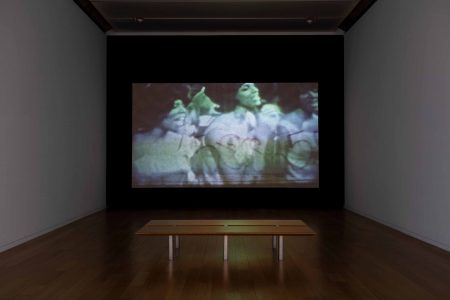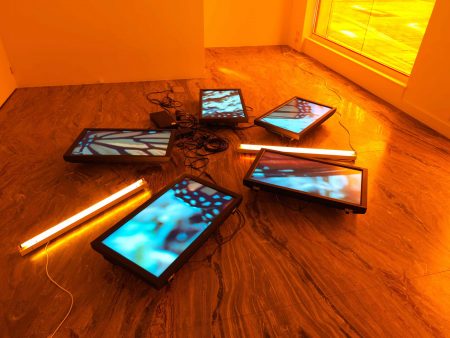Hauser & Wirth’s Los Angeles location celebrates their five-year anniversary with In Focus: LA Artists through August 22. The retrospective gathers notable artists from around Los Angeles to celebrate the city’s vibrant artistic community which has served a role in supporting the presence of the gallery. The exhibition will notably take part in Gallery Weekend Los Angeles – a weekend designed to encourage art lovers to re-embrace galleries and denote the hope of a more stable future following the pandemic. The exhibition purposefully gathers artists who’ve remained a presence around the city’s galleries and colleges – from CalArts and Artcenter to UCLA. In doing so visitors are provided with a healthy diversity of form and media. Some of the pieces highlight the contrasting styles of the artists, while some appear to work together to reflect overlapping interests. The exhibition’s variety doesn’t immediately grant a thematic through line. Rather, you have to look for threads which are guided by the vibrant energy of the city itself. At its most powerful, this collection grapples with the Los Angeles tensions between urbanity and the natural environment. The subtexts of many of these pieces are in tune with the smoke and orange skies driven by California wildfires.

Mark Bradford, Dancing in the Street, 2019
Video, Exhibition Copy, 2 mins, 50 sec
Mark Bradford’s pieces welcome tension. Within the exhibition, his Dancing in the Street might be an easy one to overlook. It loops in a private room directly to right of the entrance, but the darkness of the room doesn’t casually invite human presence. It also contrasts the rest of the exhibition as the only piece of video. Bradford, who grew up in LA, presents a short, mesmerizing piece of filmmaking. The initial layer is old footage of a troupe of black female dancers, performing what appears to be a 50s show piece. It took me a few rotations through the 2 minutes and 50 seconds to notice that that footage, within the video frame, appears to be projecting from a vehicle driving along city streets – hence the title. This layering illustrates tensions between entertainment and lived experience. The footage is jovial and filled with smiles, and the dancers are specifically styled. The streets themselves are largely dark and empty without the choreography of the dancing, granting them an ominous aura. The tension inherent in the projection of one thing upon another insinuates that this kind of dancing is incompatible with streets like this. The timeline is off, and that vision of culture is from a bygone performative era. In this timeline, Bradford might be celebrating the power of black women in LA, but he might also be calling attention to the dangers that the streets might impose upon them.

Mark Bradford, Untitled, 2020
Mixed media on canvas
360.7 x 586.7 cm / 142 x 231 in
The piece becomes even more interesting in context with Bradford’s other work in the exhibition. A giant canvas painted with mixed mediums might strike chords of anxiety. This piece nixes streets to depict a natural landscape vision, contrasting the urban tensions of Dancing in the Street. Slight hints of blue make their way around the edges, but the canvas is dominated by sharp browns and oranges. Those blues seem to be layered beneath the browns and oranges suggesting that a later iteration of the work might find them completely covered. The chaotic mixture suggests burning, as the brown streaks wiggle upward and leftward in smoky patterns. If this is a natural vision it is, of course, inflected by the unnatural influences of urbanity. The burning within Bradford’s image seems to be an anxiety shared by some of these artists, engaging with the more fragile aspects of life in Los Angeles in this time of environmental instability. The remarkable tension between the urban and natural environments around Los Angeles are challenging to reconcile, evidenced by Bradford’s rupturing of them into separate visions.

Charles Gaines, Numbers and Trees: London Series 1, Tree # 10, John Carpenter Street, 2021
Acrylic sheet, acrylic paint, photograph, 3 parts
Overall: 241.3 x 335.9 x 14.6 cm / 95 x 132 ¼ x 5 ¾ in
Charles Gaines directs his attention more explicitly toward nature. Numbers and Trees consists of a large image of a tree which is overlaid by what appears to be a digital tree. Vivid colors consisting of tiny squares with numbers grow from the bottom of the acrylic sheet, giving it an air of both naturalism and artifice. The squares do resemble another tree, yet it also clearly resembles a computer-generated image (each square is, in fact, acrylic paint). It’s a tricky piece. The vivid colors clearly obscure the natural image – what appears to be a beautiful one at that. Those colors, however, are inviting and attractive. It’s almost as if they comment on the increasing power of technological invitations toward human consciousness. The more humans become ingrained in social media and web shopping, the more lived reality shifts away from natural states. There are literally a couple of inches of acrylic separating the natural and digital. While there is no burning here, the anthropocentric influences overlap.

Diana Thater, Untitled (Butterfly Videowall 2), 2008
5 flat screens, 1 media player, 2 LED lights, window film Edition of 1 + 1AP
With her piece that I was surprised to find was made in 2008, Diana Thater weaves together technological immediacy and the environment within the gallery space. Her five screens each take microscopic views of butterfly wings, which flicker among the frames. They are, perhaps purposefully, not beautiful images. They’re too zoomed in to really capture the beauty or essence of such a creature. It’s as if Thater blames her own camera’s visual failure. Joined by the screens are a pair of LED lights and tinted windows to match, performing a grander reflection. The striking orange of the windows encapsulates the entire space, allowing light to flood the floor and walls. It reminds me of driving through downtown Los Angeles during the height of forest fire season last year. The city resembled a scene from a science fiction film, as if the orange sky itself was burning. Within Thater’s context, the screens holding the butterflies connect with orange skies to recall the failures of anthropocentric control over nature.
Gary Simmons, then, seems to take the most explicit of stances. His wall collects a number of oil paints that resemble protest signs (more works with surprising dates of origin). Each one contains a message that might have been utilized by people watching last summer’s George Floyd protests from the outside in. One might also imagine these words transmitting through police radios. Two read, “Marked Increase of Property Damage”, one “They’re Armed & Organized” while another ominously reads, “Where There is Fire, There is Smoke.” The words in each image appear to be slowly burning in their own way so as to subvert the anxieties of power structures on their heads. Some people might fear the shattering of windows or the potentiality of what a large crowd might be capable of. Yet, Simmons subversion identifies the willingness to turn a blind eye to the smoke surrounding the Los Angeles stage that hosts these fears, resisting changes of infrastructure.

Richard Jackson, STUNGUN, 2020
Neon, Edition of 3 + 2 AP
30.5 x 86.4 x 10.2 cm / 12 x 34 x 4 in
Richard Jackson’s work appears to reach for a similar subversion. His two neon signs read “FUNUG” and STUNUG” or, “FUN – GUN” and “STUN – GUN.” The inverted order of the letters allows the light to cleverly blink back and forth, as if each pair is both separate and connected. He also taps into tensions of American violence, remarking on the commercialization of weapons. They might recall the feeling of stumbling upon a bodega at night with a faulty neon sign. This bodega happens to sell guns to easy patrons. If Simmons signs represent the anxious messages between power structures and protestors, Jackson’s are concerned with the deep embeddedness of specific cultures within the American subconscious – in this case, gun culture. It’s another tense subculture within fractured American political discourses. His is a clever use of the contemporary neon trend that all too often leads toward messages that are either too vague or too obvious.
There are a number of other pieces within the exhibition, however, the collection seems most captivating when the pieces grapple with the fragility of the place wherein they were made. Los Angeles has always been a place of tension between artifice and lived reality. Those tensions evolve with time. For a transplant like myself, there was simply no way to find any intimacy with the essence of the place unless I lived here. Popular cultural images of Los Angeles, more so than most places, seem to provide such a small microcosm of what actually permeates the core of the city. As the years pass, the environment continues to buckle and the rents increase, it’s a place that seems increasingly surreal. Lived realities are reaching into realms that appear to be more and more like science fiction. Most of these pieces avoid calls to action, rather doing the work of making sense of the layers of such a metropolis. Many of the vibrant colors in this exhibition reflect a vibrant city. They also reflect the vibrant tensions facing the city.
–Josh Beckelhimer



